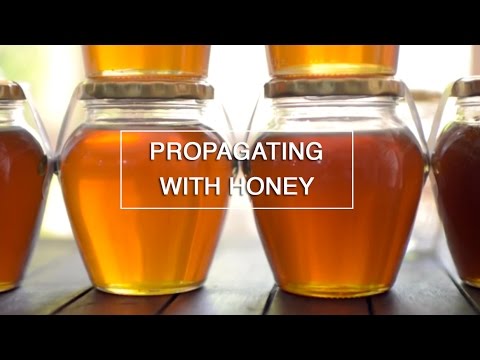Honey as Rooting Hormone?
You can buy many synthetic rooting hormones which include liquids, powders and gels that can promote rapid root growth in cuttings, but if you’re an organic gardener or just want to go the chemical-free route, we recommend using honey as a rooting stimulant.
Did you know that honey contains enzymes that can help promote root growth in plants? That’s true. Many people have had success rooted cuttings using honey. If you like honey, you might like to give it a try too. Read on to learn more about how honey can help you take cuttings.
Honey is known for its many health benefits. Aside from being an antiseptic, it also has anti-fungal properties, which are two reasons it is believed to have such a strong effect as a root hormone. Just 1 tablespoon (15 mL.) of honey is said to contain about 64 calories and 17 grams of carbohydrates, much of which comes from sugars, and seems to provide plants with the energy they need just as much as we do.
Honey is thought to contain possible rooting agents. Additionally, it is thought to guard against bacterial or fungal problems, allowing the little cuttings to remain healthy and strong.
Since honey contains anti-fungal and anti-bacterial properties, it works well as a natural rooting hormone. Honey protects cuttings from pathogens and stimulates a natural root growth hormone within the cutting.
The roots of some plants will successfully take root on their own without the use of rooting hormones, while the roots of other plants require a little assistance. Growing cuttings from cuttings is unlikely to yield 100% success, but rooting hormones can improve your chances of success.
Honey vs Synthetic Rooting Hormones
Honey demonstrated a strong ability to root cuttings in a study done by the University of Hawaii’i, but it wasn’t as effective as synthetic rooting hormones. One study is enough to conclude that although honey does not have the same immediate results as synthetic hormones, it can improve the success rate of propagation and provide better results when compared with no hormones at all.
Maintaining cleanliness while propagating is also important. Cleaning and sanitizing your equipment is essential for growing healthy plants.
The Recipes
If you are willing to try this natural method, you will probably find more than a few recipes floating around, all of which can be used. However, you might want to experiment to find the one that works best for you, yielding the best results. -Some people even add honey to their willow water to aid in rooted cuttings. -But here is a basic recipe that I have found for making your honey/water mix (this can be adjusted as necessary).
1 tbsp (15 mL) of pure or raw honey – Honey that has not been processed/pasteurized, thus losing its beneficial qualities, is said to yield the best results and yield the greatest results. Make sure the label specifies “raw” or “pure” honey when purchasing store-bought honey.
2 cups (0.47 L.) boiling water – Mix the honey with your hot water, but do not boil the honey itself. Let it cool. The mixture should keep for up to 2 weeks in a tightly sealed container (such as a mason jar) in a place that does not receive light.
Pure Honey
Heating honey destroys honey’s natural antibacterial and antifungal properties, which is why organic raw honey is best . Heat has been used to treat most honey from stores, therefore it cannot be used for propagation.
You can also add a pinch of cinnamon to the raw honey.
By infusing cinnamon into the cuttings, these natural rooting hormones are able to develop roots as a result of their antibacterial and antimicrobial properties.
Which plants can be propagated with honey?
Honey can be used for any type of cuttings including soft-wood, green-wood, and hard-wood cuttings, such as camellias, hydrangeas, and geraniums. Even succulent cuttings may benefit from honey.
The Procedure
First you need to prepare your cuttings. The cuttings vary in length depending on the plant, but should be approximately 4 – 6 inches long and cut at a 45-degree angle.
Cuttings can be taken at other times of the year, but they may end up taking longer to form roots. Cuttings taken late in the year are still useful, but they should not be used until later in the year.
Once you have your cuttings prepared, dip each cutting in honey and form a hole with your finger in the potting mix for each cutting.
Put your cuttings in the honey mixture and stick them in your chosen potting medium. Honey for cuttings can be used with any number of potting materials, from soil, to water, to rockwool.
When using a soil-based medium, it is best to poke a hole for each cut with a pencil (or your finger). Also, keep the soil moist. (If necessary, cover the soil with ventilated plastic). Your cuttings in honey can also be placed directly in the water after they have been placed in a soilless medium.
The roots will typically appear in 7-14 days with moist potting media.
The bottom portions of succulent leaves will begin to grow roots in weeks after they have been dipped in honey and placed on the potting soil.
You can also propagate cuttings in water by dipping them in honey and then placing them straight in the water.
Once your cuttings are dipped in the solution and placed in their potting medium, simply wait for them to root, which should happen within a week or so. Once the roots reach about an inch in length, they can be potted up.
It’s my hope that this article has given you some inspiration to try honey next time you’re preparing your cuttings.


